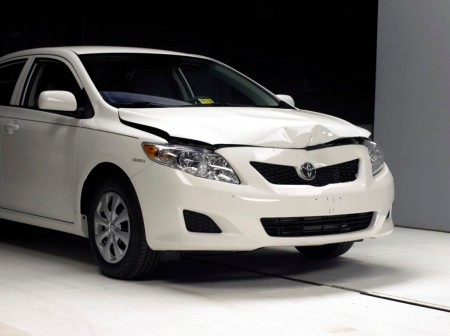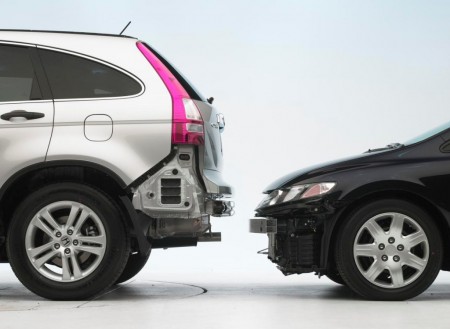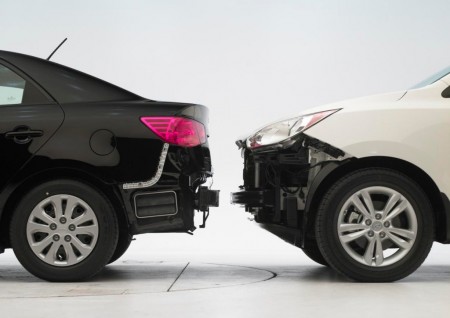U.S. IIHS study says low-speed car-SUV crashes expensive

Say what you want about the Americans, but they are a serious bunch when it comes to safety. The U.S. government’s National Highway Traffic Safety Administration — NHTSA — is the one that mandates airbags and tyre-pressure monitors in all new cars, subdued automakers into making their roof strength higher while inadvertently making outward visibility worse due to thicker pillars, and is set to force rear-view cameras on all new cars by 2014 thereby making car prices higher. And if that weren’t enough, there are not one, but two agencies in the U.S. that conduct crash tests, one being the NHTSA and other being the private Insurance Institute for Highway Safety — IIHS — formed by a consortium of insurance companies. Watching from outside, one would think the Americans are a bunch of phussies, but they do come out with interesting information. The latest IIHS report suggests that cars crashing into SUVs cost a lot of money to fix, an obvious conclusion for sure, but at different levels for different brands.
Bumpers on cars are designed to match up with each other in low-speed collisions, but a long-standing gap in U.S. federal regulations exempts SUVs from the same rules. New IIHS crash tests demonstrate that SUV bumpers that don’t line up with those on cars can lead to huge repair bills in what should be minor collisions in stop-and-go traffic.
A U.S. federal standard requires that all cars have bumpers that protect within a zone of 400 to 500 mm from the ground. This means car bumpers line up reasonably well and are more likely to engage during low-speed collisions to absorb energy and prevent damage. No bumper requirements apply to SUVs, pickups, or minivans, so when these vehicles have bumpers they often are flimsier and higher off the ground than bumpers on cars.
In fender-benders with SUVs, cars often end up with excessive damage to bonnets, engine cooling systems, fenders, bumper covers and lights. SUVs don’t always come out unscathed either, often needing extensive work.
The Institute conducted 16 kph front-into-rear crash tests involving seven pairs of 2010 models, each composed of a small car and small SUV from the same automaker, to show the discrepancies within the same brand even.
In the tests, an SUV going 16 kph struck the back of its paired car, which was stopped. Then the configuration was reversed, with the car striking the back of its paired SUV. Results of these low-speed impacts varied widely, from a total of US$ 850 damage to one vehicle to US$ 6,015 damage to another. In some cases, the crash damage included major leaks from broken radiators and cooling fans.

If bumpers don’t match up, they’ll bypass each other when vehicles collide, and the resulting crash energy will crumple the vehicle body. That’s what happened when the Nissan Rogue (an American variant of the Nissan Qashqai) struck the back of the US-spec Nissan Sentra compact sedan in the SUV-into-car test. The Rogue’s front bumper didn’t line up at all with the Sentra’s rear bumper, and the resulting US$ 4,560 rear damage tally for the Sentra was the highest among all the cars in this test. The impact crumpled the car’s bumper cover, trunk lid, and rear body. The Rogue ended up with a crushed and leaking radiator that kept the SUV from being driven after the test.

Bumper height mismatch contributed to pricey damage when the Ford Escape struck the rear of the Ford Focus. Their bumpers overlapped less than 2 inches, not enough to protect the Focus’s rear body and trunk lid from US$ 3,386 in repairs. The mismatch problem with the Ford pair was even worse when the Focus struck the back of the Escape. The front bumper on the car underrode the high-riding Escape’s rear bumper, which at 25 inches off the ground is the tallest among all the small SUVs evaluated this time around. Damage to the Focus came to US$ 5,203 and included replacing most of the sheet metal plus many parts in front of the engine.

When the Toyota Corolla hit the rear of the Toyota RAV4 in the car-into-SUV test, damage amounted to nearly US$ 10,000 for the pair, the highest combined test damage among all of the vehicle pairs evaluated. The RAV4 accounted for about US$ 6,000 of the bill. Apparently the RAV4’s so-called bumper is really just a stamped piece of sheet metal supporting the bumper cover, so the striking Corolla hit the spare tyre mounted on the RAV4’s tailgate. The spare isn’t designed to absorb crash energy, so it damaged the Corolla’s bonnet, grille, headlights, air conditioner, and radiator support and crushed the RAV4’s tailgate and rear body panels.

Bumpers on Honda’s CR-V and Civic were the most compatible in the SUV-into-car test, and at US$ 2,995 the pair had the lowest combined estimated damage in this crash test. The Civic’s US$ 1,274 damage was the lowest among the cars. The CR-V is one of only 3 SUVs whose front bumpers overlapped half of the rear bumpers on the cars they hit.

When the Kia Cerato struck the back of the Hyundai Tucson, their bumpers matched up well enough to keep the Forte from underriding the SUV, limiting damage to a combined US$ 3,601 for both vehicles. The Cerato’s US$ 1,510 repair estimate was the lowest among cars in the car-into-SUV test. The Tucson’s US$ 850 damage estimate was better than the other SUVs, and it was the only SUV that didn’t have a damaged air-conditioning condenser. Despite bumpers that aligned, results for the Cerato weren’t as good. The Cerato had more than US$ 3,000 rear damage because its bumper broke during impact. The car’s rear body panel also was damaged.
According to the IIHS, combined damage estimates run into thousands of dollars for even the best performers. In the real world that money comes straight out of consumers’ wallets through high deductibles and insurance premiums. Regulating SUV bumpers would ease the burden.

The IIHS has been bugging the NHTSA to yet again force carmakers to make lower SUV bumpers. The NHTSA have long said that requiring light trucks to have bumpers would compromise off-road maneuverability. The IIHS counters that very few SUVs are used off-road anyway.
















Comments
Aarav
how stupid do ppl hav to be to crash into another car at 16km/h at the lights??? 😛
Nittin
Rear view cameras are for lady-drivers!!!!!
*DISAPPOINTED*
snapneck
The Tucson is not an SUV
abudhabi_cars
interesting but not 100% true..
had a low speed crash at national day celebrations.
a honda jazz bumped into my lc..
no damage to lc
honda jazz got a few scratches..not even worth 5$ at sharjah garage…:P
Bjorn
Rear view cams are helpful specially when backing out unaware that some kid shorter than your trunk top stopped to play or pick up something. You may say that this is the parent’s or the kid’s fault for being in such a wrong place at the wrong time but kids will be kids and when you do knock one down, the police & the judge will have a hard time believing you before handing down a blood money compensation, jail & deportation. Believe me it can happen to anyone. Better safe than sorry.
ROJ
This gap is really serious when it comes trucks and suvs that are high and end up shaving the car’s roof or going under it in the event of a smaller car crashing in its back…
They should make a strict here law about those large truck trailers as their bumpers are high and i wouldn’t even want to tell about what happens to an avg. size sedan when crashing into it cuz basically its an a-pillar to bumper collision..
Still i dont buy the idea of making an excuse to stuff more expensive technology for extra safety in an entry level car which makes it cost hell..
aaron
Yea who crashes at such a small speed, plus what a waste of cars, will they repair them or what?
v6turbo
This just car to small crossover. You hit a midsizer or full sizer suv, then front is gone. Apart from Pajero and certain models of 4×4’s the concept of tyre in tail gate is gone. All the tires are at bottom, so first the car will be under 4×4 second the spare tyre under will bounce it back. As mentioned above, in case of bigger trucks its very dangerous.
Nittin
Crashing at 16 kmph happens a lots… that’s when someone travelling at higher speeds slam their brakes and don’t stop in time
ROJ
For those getting angry about wasting the cars for nothing.. The point is not about slow speed crashes but the fact that bumpers of different cars are not compatible which not only costs more to fix in a slow speed collision but is also dangerous in faster accdients.. This will change the way they manufacture cars.. I believe they will set a standard for bumper heights in all new cars from now on..